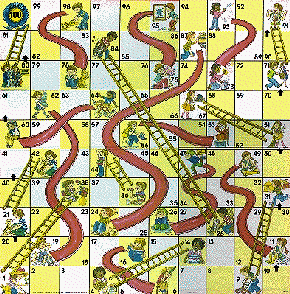2007.02.18 18:18
what is today's movement?
Name any current mathematical, scientific or philosophical theory, and there's an architecture that will try to reenact it.
Look at the architecture of Mies, Le Corbusier (especially the late works), and Kahn (especially the early works), and there's a lot of contemporay architecture reenacting all that.
Philip Johnson's architecture is one reenactment after another.
Frank Gehry's architecture evolves via reenacting itself.
You want something original? Just reenact with a twist.
twist
–verb (used with object)
1. to combine, as two or more strands or threads, by winding together; intertwine.
2. to form by or as if by winding strands together.
3. to entwine (one thing) with another; interlace (something) with something else; interweave; plait.
4. to wind or coil (something) about something else; encircle; entwine; wreathe.
5. to alter in shape, as by turning the ends in opposite directions, so that parts previously in the same straight line and plane are located in a spiral curve.
6. to turn sharply or wrench out of place; sprain.
7. to pull, tear, or break off by turning forcibly.
8. to distort (the features) by tensing or contracting the facial muscles; contort.
9. to distort the meaning or form of; pervert.
10. to cause to become mentally or emotionally distorted; warp.
11. to form into a coil, knot, or the like by winding, rolling, etc.
12. to bend tortuously.
13. to cause to move with a rotary motion, as a ball pitched in a curve.
14. to turn (something) from one direction to another, as by rotating or revolving.
15. to combine or associate intimately.
–verb (used without object)
16. to be or become intertwined.
17. to wind or twine about something.
18. to writhe or squirm.
19. to take a spiral form or course; wind, curve, or bend.
20. to turn or rotate, as on an axis; revolve, as about something; spin.
21. to turn so as to face in another direction.
22. to turn, coil, or bend into a spiral shape.
23. to change shape under forcible turning or twisting.
24. to move with a progressive rotary motion, as a ball pitched in a curve. 25. to dance the twist.
–noun
26. a deviation in direction; curve; bend; turn.
27. the action of turning or rotating on an axis; rotary motion; spin.
28. anything formed by or as if by twisting or twining parts together.
29. the act or process of twining strands together, as in thread, yarn, or rope.
30. a twisting awry or askew.
31. distortion or perversion, as of meaning or form.
32. a peculiar attitude or bias; eccentric turn or bent of mind; eccentricity.
33. spiral disposition, arrangement, or form.
34. spiral movement or course.
35. an irregular bend; crook; kink.
36. a sudden, unanticipated change of course, as of events.
37. a treatment, method, idea, version, etc., esp. one differing from that which preceded.
38. the changing of the shape of anything by or as by turning the ends in opposite directions.
39. the stress causing this alteration; torque.
40. the resulting state.
41. a twisting or torsional action, force, or stress; torsion.
42. a strong, twisted silk thread, heavier than ordinary sewing silk, for working buttonholes and for other purposes.
43. the direction of twisting in weaving yarn; S twist or Z twist.
44. a loaf or roll of dough twisted and baked.
45. a strip of citrus peel that has been twisted and placed in a drink to add flavor.
46. a kind of tobacco manufactured in the form of a rope or thick cord.
47. a dance performed by couples and characterized by strongly rhythmic turns and twists of the arms, legs, and torso.
48. the degree of spiral formed by the grooves in a rifled firearm or cannon.
49. Gymnastics, Diving. a full rotation of the body about the vertical axis.
50. a wrench.
[note to self: reenactment with a twist, is that what Hejduk's architecture is really all about?]
| |
2007.03.09 22:02
...and speaking of random tangents
The four architects had decided to achieve an effect of harmony and therefore not to use any historical style in its pure form. Peter Keating designed the white marble semi-Doric portico that rose over the main entrance, and the Venetian balconies for which new doors were cut. John Erik Snyte designed the small semi-Gothic spite surmounted by a cross, and the bandcourses of stylized acanthus leaves which were cut into the limestone of the walls. Gordon L. Prescott designed the semi-renaissance cornice, and the glass-enclosed terrace projecting from the third floor. Gus Webb designed a cubistic ornament to frame the original windows, and the modern neon sign up on the roof, which read: "The Hopton Stoddard Home for Subnormal Children."
"Comes the revolution," said Gus Webb, looking at the completed structure, "and every kid in the country will have a home like that!"
The original shape of the building remained discernable. It was not like a corpse whose fragments had been mercifully scattered; it was like a corpse hacked to pieces and reassembled.
Ayn Rand, The Fountainhead (1943), pp. 385-6.
Is anyone reading Frascari's Monsters of Architecture these days?
Are monsters merely crazy, mixed-up reenactments?
2007.07.11 17:52
Verb: Featured Discussion
C(riticism) = m(ainstream)Ad(vertising)²
2007.11.29 19:19
Does research kill architectural creativity?
I would never say that reenactment is duplication. Reenactment is a process that just happens to underlie a lot of creative operations.
In architecture, the notion of walls, floors, doors, windows, etc. are constantly reenacted, but not necessarily duplicated.
2008.07.05 10:27
Can you say canonical?
...read the 'Introduction' and be aware of Eisenman's ongoing oppositional reenactment of Colin Rowe's analytical method (which ultimately reaches farce in the analysis of the 10th canonical building).
One could almost describe Eisenman's whole architectural design career as one oppositional reenactment after another, finally punctuated with bursts of intense originality (like the Max Reinhardt Haus, Haus Immendorf and the Staten Island Institute of Arts and Sciences).
2008.10.20
AinCC, continued
"Eternal Wrest" will have to do with reenacting with a twist as a constant generator of originality.
| |
2008.10.25 11:20
front-line ideas + regional tradition = potential for a design culture of thinking/making?
"Eternal Wrest" is mostly about "reenactment with a twist".
See Emmanuel Petit's "Incubation and Decay: Arato Isozaki's Architectural Poetics--Metabolism's Dialogical "Other"" also in Monster.
or
1999.12.09
quick response, good trip
I know of the Metabolists, but not their writing/ideas per say. More recently I’ve read what Isozaki says in retrospect regarding the Metabolist movement, and there he actually raises the issue of destruction not having been part of the original Metabolist credo, although, as he now sees it, destruction should have been a part of it. What I most like about metabolism as a process is that there has to be both creation and destruction in order for the process to work (otherwise none of us could even literally live). Moreover, I see humanity today demonstrating a high (and rising) degree of metabolic imagination.
2003.09.26
metabolism
On the occasion of the World Design Conference held in Tokyo in 1960, a group of young 30-something Japanese architects proposed “metabolism” as a new ‘ism’ for architecture and urban planning. Their idea was quite simple: architecture and the city should constitute an open living organism that grows through metabolism, instead of an enclosed, static machine.
Arika Asada and Arata Isozaki, “From Molar Metabolism to Molecular Metabolism” in Anyhow (1998).
What the Metabolists failed to realize is that metabolism (as a physiological operation) is a creative/destructive duality, hence, metabolism does not define a continuous organic growth, as much as growth integral with equal measures of destruction.
Schumpeter called capitalism “creative destruction,” which, if correct, essentially labels capitalism as being metabolic. There is no question that we live in very metabolic times. Unfortunately, most (product) designers today (seem to) remain oblivious to the fact that what is great design today will soon enough be tomorrow’s trash.
2009.01.29 11:18
lost endings
...like the fore and aft of Finnegan's Wake or the role of Sepulchrum Mariae Honorij Imp. Uxoris, Stiliconis filiae within Il Campo Marzio.
2582
2985a
2009.06.12 14:36
please comment or destroy, thank you
"In German, a mnemonic can be fashioned from the literal meaning of the Latin word complicare. which means "to fold together (zusammenfalten)": the complicated, then, can be rendered graspable via unfolding (Entfaltung), because it thereby becomes simple (einfach) in a sense of naïve or ingenuous (einfältig). But the Latin word complexus means "mutual embrace," or, so to speak, the labyrinthine [emphasis added], the convoluted: here, simplicity already contains within itself the seed of all the complexity that comes to appearance through its own development. In cases of doubt, then, the complicated can be profitably reduced and simplified--but the complex, in contrast, cannot be simplified with impunity. To say that something is complicated means that the finite number of its determinations cannot be grasped directly. To say that something is complex means, by contrast, that the number of its determinations is simply infinite."
Clemens Bellut, "Ach, Luise, lass ... das ist ein zu weites Feld," or: The Gordian Knot of Complexity” in Complexity: Design Strategy and World View (2008).
Eternal wrest ... really only the beginning?
"All the world's a next stage."
| |
2009.02.21 18:20
Bilocation Syndrome
Yes, museum as eternal wrest.
Otherwise, think of it as

meets

meets

[Especially match the symbols memory game.]
| |
2011.02.17 11:00
The Most Obvious Path
Does anyone know the definition of "the most obvious path to the realisation of a building"?
2011.02.17 13:12
The Most Obvious Path
Something (misparaphrased) tells me...
(1) architecture is illusory, and architecture is different from what we think it should be or what we would like it to be;
(2) society exacts from architecture dissimulation and falsehood;
(3) society often forces architecture to act in ways that are contrary to the architect's will (volition);
(4) if architecture is not conditioned by the forces of society, then it is certainly conditioned by [the architect's] unconscious forces, which defeat the presumption of architecture's reason and logic;
(5) therefore, we do not have just one obviousness and one path, but many;
(6) and this is so because architecture is a continuous flux; because the conceptual forms of architecture are but attempts to stop this flux at the decisive moment they do not hold but, rather, reveal architecture for what it really is--merely a mask.
2011.02.17 13:18
The Most Obvious Path
Or perhaps architecture is an actor that plays the role of architecture. Architecture uses reflection as a mirror, a mirror of reflection, the mirror of a mirror mirroring the mirror of another mirror.
"And may eternal wrest be granted unto you."
2011.02.18 15:49
The Most Obvious Path
"Decimating much 20th-century architecture, Koolhaas rejected the modernity, which, as he put it: 'has established itself with a certain obviousness in the minds of people: that modernity that contains an embarrassing fetish for light, air and hygiene; that modernity that has a painful inability to establish any meaningful relationships with the past; or that modernity that always uses, with relentless insistence, the alibi of social utility as its reason for being.' Obviously when these deletions to architecture are made, the stock of modernism is much reduced."
GB, 1981
2013.05.14 21:31
14 May
Three other variations on the theme remain for special comment. This trio have in common the idea, typical of synthetic eclecticism, of creating a new building type by combining elements from two of the most famous buildings of antiqity, the Parthenon and the Pantheon. Thus, perhaps, something new is created, something taking of the universally acknowledged excellences of these archetypes. It is too much to say that the combinations surpass either of the paradigms, but it cannot be denied that the resulting contrasts of form are productive of novel and provocative aesthetic effects. Similar juxtapositions of well-known and heavily associated forms were a commonplace in the projects of imaginative architects at this time, such as Boullee, Gilly, and Valadier; and Robert Mills proposed a combination of a Doric colonnade and an obelisk for the Washington Monument.
Carroll L. V. Meeks, "Pantheon Paradigm" (JSAH: 1960.12, 142).
Aldo Ross's Modena cemetery design of 1971 has been one of the most widely discussed architectural projects of the past decade. Now under construction, on the basis of a revised plan of 1976, Rossi's cemetery demonstrates his use of established architectural types, in unexpected combinations, to convey specific ideas about architecture and life.
Some critics, such as Manfredo Tafuri, have taken the view that the meaning of Rossi's design cannot be verbalized. This articale seeks to demonstrate that the oposite is the case. Here, Rossi's sources and writings are explored in tandem, in order to unravel the complex message contained in his cemetery design. In particular, Rossi's debts to Piranesi, Boullee, Loos, Hannes Meyer, Le Corbusier, and de Chirico are discussed.
Eugene J. Johnson, "What Remains of Man--Aldo Rossi's Modena Cemetery" (JSAH, 1982.3, 38).
Eternal Wrest in Pieces.
just thought of that while typing the above.
His book is designed as a megastructure, and we all know now their fate today.
Read together, they avail us of the opportunity to be placed both "within" and "without" at one and the same time, which none of the books on their own would allow.
Chris Fawcett, "The Rites of Criticism" (JSAH, 1980.5, 155-6).
He asserts that as early as the 18th century, Piranesi discerned that a wholly organized world is not a paradise but a nightmare. The full consequences of these contradictions, however, were not worked out until the 20th century.
I trust that Tafuri's advise will be similarly ignored.
The great value of Architecture and Utopia lies not in its political prescriptions but in its wealth of insights into the relationship between architecture and social theory since the Enlightment. Therein also lies its great frustration. The book touches on a bewildering variety of topics from Abbe Laugier to Andy Warhol until it seems less like a sustained argument than a series of brilliant asides. The pace is as rapid as the scene in Godard's "Breathless" in which the characters race each other through the galleries of the Louvre.
Robert Fishman, "Utopia and its Discontents" (JSAH, 1980.5, 153-5).
|